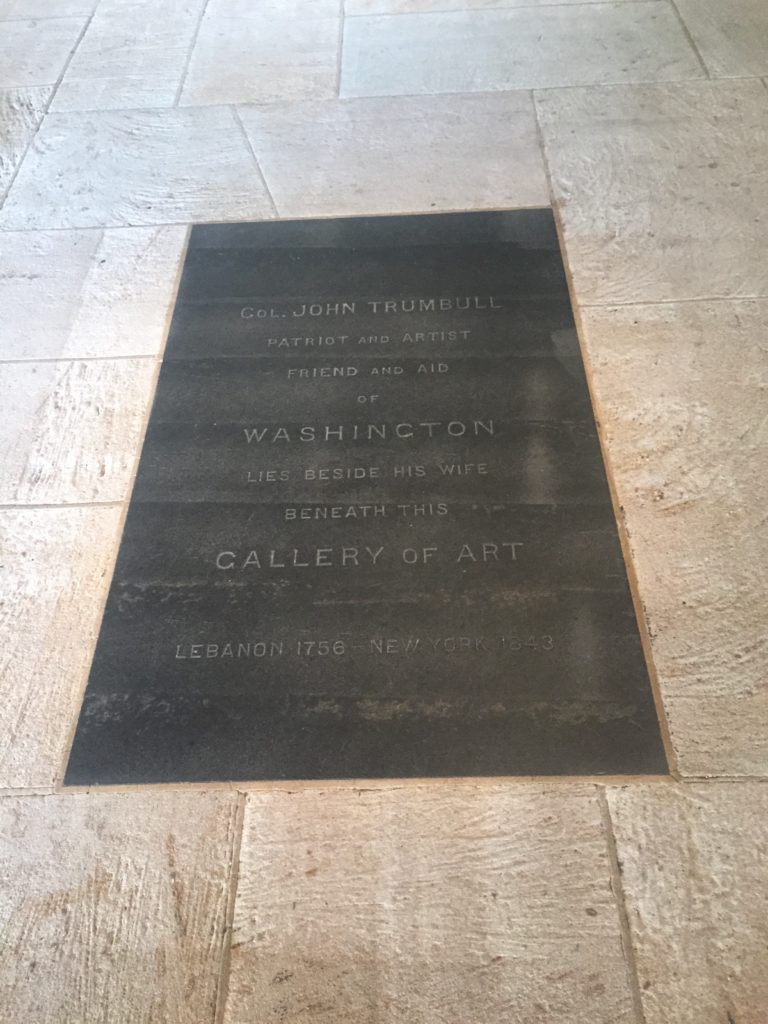Erik Visits an American Grave, Part 724
This is the grave of John Trumbull.

Born in 1756 in Lebanon, Connecticut, Trumbull grew up in the New England elite of the Revolutionary generation. His father was Connecticut governor from 1769-84, the only British governor to become a Patriot and remain in office after 1776. Trumbull entered Harvard in 1771 and graduated in 1773. He was blind in one eye, but still was a soldier in the American Revolution. Because he was so artistically inclined, his first work for the revolution was sketching the British lines for the colonialists. He rose pretty quickly in the army during the Revolution. He became Washington second aide-de-camp in June 1776 and then Horatio Gates’ deputy adjutant-general in 1777. But he resigned from the army in a huff later that year over the dating of his appointment, which I think was a seniority issue.
Instead, Trumbull turned to art. He traveled to London, even though the Revolution was still going on. Benjamin Franklin gave him an introduction to Benjamin West and Trumbull was able to study under him. But there was significant anti-American sentiment in London. When John André was captured and killed by American troops, Trumbull was thrown in prison for seven months as an act of revenge because he had been an officer near to André’s rank and basically because he was there. Bad timing. He returned to the U.S. after he was released and then helped his brother procure supplies for the army stationed in upstate New York.
After the Revolution, Trumbull returned to London for further study under West. The senior painter encouraged Trumbull to paint historical scenes and soon he became the master historical painter of the United States. Few had more success in building the mythology of the Founding Fathers than Trumbull, including painting the legendary Declaration of Independence signing picture so famous today, as well as the surrender of Lord Cornwallis painting that is also commonly known. He began to be shown in London and he traveled to Paris for further study and to do sketches of French officers for his American Revolution paintings. He met Thomas Jefferson there, who helped him plan out the Declaration of Independence painting. He wanted to get everyone exactly right, so he went around visiting which signers he could and then making copies of paintings of those who had already died.
Trumbull returned to the U.S. But he really wasn’t wealthy. He had to get commissions in his home country. A lot of this was portraiture. Gilbert Stuart was the premier portrait painter in America, but Trumbull was close behind him. He painted some of the most iconic paintings of Washington and Alexander Hamilton. He also worked as John Jay’s secretary in London during the negotiating of the Jay Treaty, which was unfairly maligned by Americans who thought they had a lot more power than they did. He traveled around Europe after that and was the first person outside the diplomatic team to discover the XYZ Affair in Paris that so inflamed anti-French sentiment in the U.S. Trumbull carried the first news of this back to the U.S. He was in Europe quite a bit during these years, continuing to hold diplomatic posts in London and just living in Europe for quite a bit of time between 1804 and 1817. The Embargo Act, Jefferson’s idiotic foreign policy decision to simply cut off trade with most of Europe in a snit, really undermined Trumbull financially. His eyesight declining, in 1809 he went back to Europe for treatment and stayed there until after the end of the War of 1812. In 1826, Congress commissioned four large Revolution paintings. These are the history paintings in the Capitol rotunda.
Trumbull lived a long time and as the 19th century progressed, his style and subject matter became outdated. Sitting for pricey portraits didn’t interest Martin Van Buren and John C. Calhoun as much as it had their predecessors. Trumbull really didn’t have much money. Finally, he gave Yale a big chunk of his work in exchange for a $1,000 stipend per year, which at least gave him stability. He had become the president of the American Academy of Fine Arts in 1816, but his unwillingness to adjust his styles alienated the next generation of artists, who finally abandoned his school entirely and founded the National Academy of Design in 1825, which still exists as an honorific society today. But Trumbull’s American Academy of Fine Arts suffered a fire in 1839 and did not reopen as it was so out of fashion; he had finally stepped down as heading it in 1836. Trumbull then tried to raise some money by writing an autobiography, which he published in 1841. He died in 1843, at the age of 87.
Let’s look at some of Trumbull’s work.




John Trumbull is buried beneath the Yale Art Gallery, New Haven, Connecticut. I also really miss going to this wonderful museum. Someday life will return to normal.
If you would like this series to visit other American artists of the early 19th century, you can donate to cover the required expenses here. Thomas Cole is in Catskill, New York and Asher Durand is in Brooklyn. Previous posts in this series are archived here.


